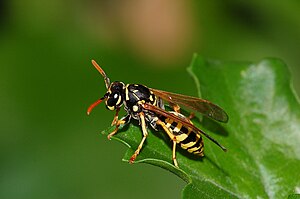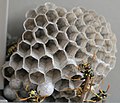Gallic field wasp
| Gallic field wasp | ||||||||||||
|---|---|---|---|---|---|---|---|---|---|---|---|---|

Gallic field wasp ( Polistes dominula ) |
||||||||||||
| Systematics | ||||||||||||
|
||||||||||||
| Scientific name | ||||||||||||
| Polistes dominula | ||||||||||||
| ( Christ , 1791) |
The Gallic field wasp ( Polistes dominula , syn .: P. gallica ), also called the French field wasp or house field wasp , belongs to the genus Polistes within the family of the folded wasps (Vespidae) .
features
Gallic field wasp workers and drones reach a body length of 11 to 15 mm, queens are around 18 mm long. On the abdomen (abdomen) they have a very variable, yellow-black pattern. Two conspicuous yellow spots can be seen on the second abdominal segment (abdominal tergite), while the other tergites are striped yellow. The underside of the last abdominal segment is yellow. Usually the head shield (clypeus) is completely yellow, with more southern individuals also provided with a black spot in the middle.
The Gallic field wasp differs from the other Central European wasps in that it has quite long legs that hang conspicuously downwards when it flies. The lower third of the legs are clearly orange, and the antennae are yellow-orange from the third limb.
Occurrence
The continuing spread of the wasp species in Northern Europe is very remarkable. Until a few years ago no occurrence was known in northern Germany ; since the end of the 20th century it expanded its range to Denmark . Native to southern and central Europe and Asia , they have meanwhile been abducted to Japan , Australia , North America and Chile ; there, too, they have spread very widely.
The animals inhabit open and warm areas, such as meadows and bushy heaths, and also like to build their nests in the human settlement area . They occur there regularly to frequently and fly from mid-March to September.
behavior
The very useful Gallic field wasps often only defend themselves in the event of massive disturbances, e.g. B. by humans. Otherwise they are very peaceful.
nutrition
They feed predatory on other insects and spiders , but also on flower nectar .
Nest building and reproduction
The nest of the Gallic wasp is usually founded in spring by a young queen or usually by several people together. Wood putty, which is mixed from wood from dried plant stems and the secretion of the salivary glands , is used as the building substance . The small, sheathless (outwardly open honeycomb) nest is usually built vertically on a nest stem (as a bottleneck, good defense options) or outside on a stem or stone and consists of about 50 cells, but it can sometimes contain up to 150 cells and reaches a diameter of about 10 cm. Occasionally, nests are also built in cavities, for example in the metal pipes of bridge railings. The nest is looked after by up to around 30 workers. It is possible for the workers to regulate the temperature in the nest: when it is hot, they absorb water from standing water or other water sources and spit it on the nest, then the wings are fanned to cool it; when it's cold, their muscles tremble and give off heat.
Shortly after the egg-laying, the strongest queen eats the brood of the competitors until they give up the egg-laying and only work as workers. Should the strongest female die, the second strongest follows to her position. The workers feed the larvae and their queen insects (mostly flies ) and spiders, which they chew up and pass on in spherical form. From early June to slip the first workers and the end of July males and females of the next generation of the honeycomb . The Gallic wasps perish in September, only the young queens overwinter.
Diseases and parasites
The Gallic field wasp can be attacked by parasitoid fan-winged birds of the species Xenos vesparum .
More pictures
When releasing ( regurgitation ) a swallowed drop
supporting documents
literature
- Wilhelmine M. Enteman: Coloration in Polistes (= Carnegie Institution of Washington. Publication 19, ISSN 0099-4936 ). Carnegie Institution of Washington, Washington DC 1904.
- Delfa Guiglia: Les Guêpes sociales (Hymenoptera, Vespidae) d'Europe occidentale et septentrionale (= Faune de l'Europe et du Bassin méditerranéen. Vol. 6, ZDB -ID 416815-x ). Masson, Paris 1972.
- Stefano Turillazzi, Mary J. West-Eberhard: Natural history and evolution of paper wasps. Oxford University Press, Oxford et al. 1996, ISBN 0-19-854947-4 .
- Mary J. West-Eberhard: The social biology of polistine wasps (= University of Michigan. Museum of Zoology. Miscellaneous Publications 140, ISSN 0076-8405 ). Museum of Zoology, Ann Arbor MI1969 (Also: Ann Arbor, Univ. Of Michigan, Diss.).
Individual evidence
- ↑ Johann Ludwig Christ : Natural history, classification and nomenclature of insects from bees, wasps and ants as the fifth class, fifth order of the Linneische natural system of the insects: Hymenoptera. With membranous wings. Germanische Buchhandlung, Frankfurt am Main 1791, p. 229
- ↑ Thomas Meineke: Stylopized field wasps Polistes dominula in southern Lower Saxony. November 27, 2010, accessed July 7, 2017 .









